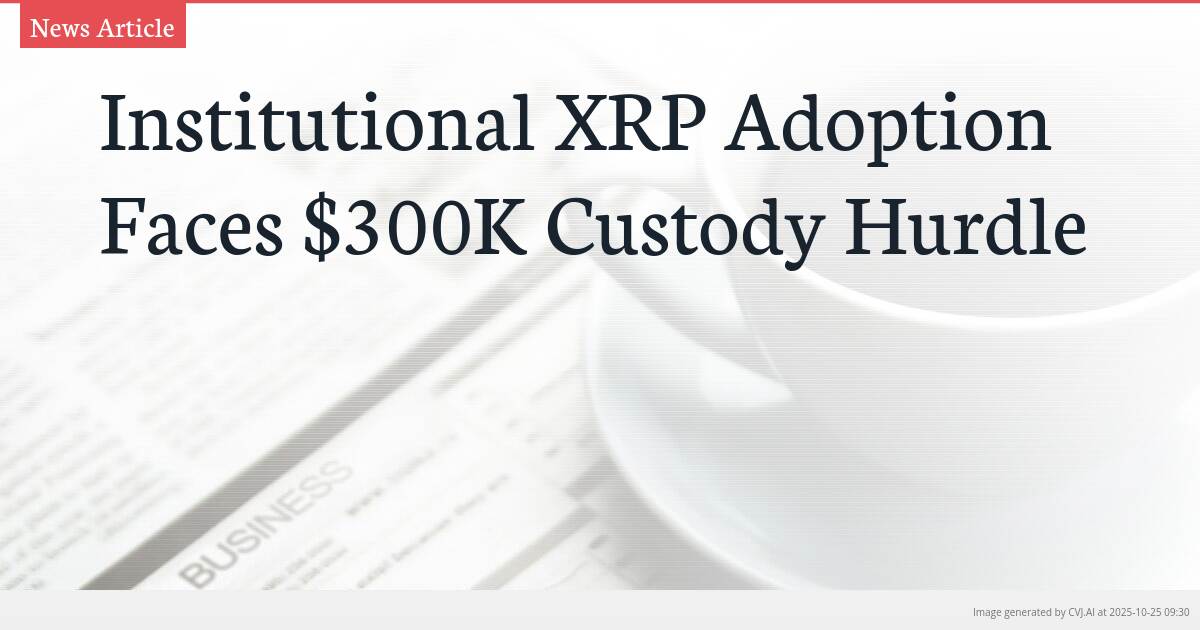This summary text is fully AI-generated and may therefore contain errors or be incomplete.
Introduction
Major financial institutions are showing renewed interest in XRP, but face a significant operational hurdle that prevents direct holdings: custody and compliance costs reaching $300,000 annually per setup. According to software engineer Vincent Van Code, this financial barrier explains why firms are increasingly turning to alternative exposure routes like ETFs and publicly traded companies with XRP treasuries, rather than holding the cryptocurrency directly on their balance sheets.
Key Points
- Institutional custody and compliance systems cost approximately $300,000 annually per setup, creating significant barriers to direct XRP holdings
- Evernorth plans to create a $1 billion institutional XRP treasury with backing from Ripple and SBI Holdings, targeting over 560 million XRP initially
- A trader recently placed a $1 million leveraged long position on XRP at $2.409 with 10x exposure, signaling strong short-term bullish sentiment among derivatives traders
The $300,000 Institutional Custody Challenge
Vincent Van Code’s analysis reveals that the primary obstacle preventing large companies from directly holding XRP isn’t price volatility or lack of interest, but rather the substantial operational and compliance requirements. According to his findings, institutions cannot simply “set up a Ledger or Xumm wallet and drop $100 million in there” but instead require formal custody arrangements, regular audits, and comprehensive compliance systems before they will engage with cryptocurrency on a large scale.
The maintenance of these institutional-grade services comes with a significant price tag—approximately $300,000 per year for a single institutional setup. This substantial recurring cost helps explain why many corporations prefer to avoid holding tokens directly on their balance sheets, despite growing interest in XRP’s potential. The operational burden extends beyond mere storage to include regulatory compliance, security protocols, and ongoing auditing requirements that many traditional financial institutions find prohibitive.
ETF Applications and Alternative Exposure Routes
With direct holdings proving operationally challenging, Van Code identifies exchange-traded funds and public companies holding XRP as the most viable pathways for institutional exposure. Currently, seven applications for XRP ETFs are pending with the US Securities and Exchange Commission, though these filings have been paused amid the ongoing US government shutdown. This regulatory pathway offers institutions the ability to gain XRP exposure without the burden of managing custody systems internally.
Evernorth has emerged as a focal point in this institutional adoption discussion. The venture, backed in part by Ripple, plans to build what it describes as an institutional XRP treasury. The company aims to purchase $1 billion worth of XRP and will begin with over 560 million XRP tokens after securing $1.1 billion in committed capital from participants including Ripple and SBI Holdings. Reports indicate the firm is pursuing a merger expected to close in Q1 2026, with XRP purchases planned to occur within 10 days of funding.
Market Activity Signals Growing Confidence
Despite the institutional custody challenges, market activity indicates growing confidence in XRP’s near-term prospects. Recent reports identified a substantial position on the Hyperliquid derivatives exchange where an anonymous trader established a $1,000,000 long position with an entry price of $2.409, representing 416,736 tokens. The position was executed with 10x leverage, suggesting strong conviction in XRP’s potential price movement.
Community figure Xaif helped highlight this significant trade, which typically indicates short-term bullish sentiment among derivatives traders. While such leveraged positions can contribute to increased price volatility, they also demonstrate that sophisticated market participants see substantial upside potential in XRP despite current institutional barriers. This activity occurs against the backdrop of Evernorth’s planned $1 billion treasury acquisition and the pending ETF applications, creating a complex landscape of institutional and retail interest converging around XRP.
📎 Read the original article on newsbtc.com

